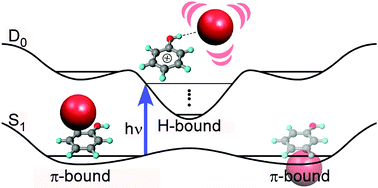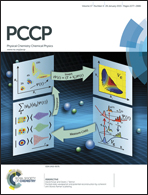Mass analyzed threshold ionization detected infrared spectroscopy: isomerization activity of the phenol–Ar cluster near the ionization threshold†
Abstract
The structure of the phenol–argon cluster (PhOH–Ar) in high-n Rydberg states is investigated by the newly developed technique of mass analyzed threshold ionization detected infrared (MATI-IR) spectroscopy. This method selectively measures IR spectra of molecular clusters in very high-n Rydberg states (n > 100) utilized in zero kinetic energy (ZEKE) photoelectron and MATI spectroscopy, whose ionic cores are essentially the same as the corresponding bare cation. The MATI-IR spectrum exhibits only the free OH stretching vibration (νπOH) when the π-bound cluster of the neutral ground electronic state (S0) is resonantly excited via the S1 origin to Rydberg states converging to its adiabatic ionization energy level, IE0(π). When Rydberg states converging to vibrationally excited levels of the local π-bound minimum are prepared, in addition to νπOH also the hydrogen-bonded OH stretching vibration (νHOH) of the H-bonded global minimum is observed in the MATI-IR spectra, even for vibrational excitation of only 14 cm−1 above IE0(π). These results show that the π → H site switching reaction of the Ar ligand from the aromatic ring to the OH group proceeds only from vibrationally excited states in the π-bound cation core with a small barrier of less than 14 cm−1 from IE0(π). On the other hand, directly photoionized PhOH+–Ar shows both νHOH and νπOH in the IR spectra, even when it is just ionized to IE0(π). This result implies that the ionization-induced π → H site switching occurs without excess energy in the H-bound or π-bound cations, in contrast to very high-n Rydberg states converging to levels of the π-bound cation. The different efficiencies of the site switching for the Rydberg ion core and the bare ion and the mechanism for the π → H site switching are interpreted by direct ionization from the π-bound to the H-bound structures in addition to the conventional vertical ionization and transitions to high-n Rydberg states.


 Please wait while we load your content...
Please wait while we load your content...